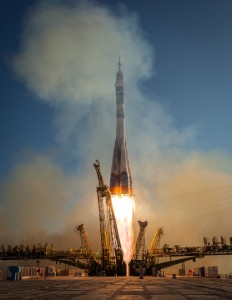Broadcasting Live … From Space
But all of this is an excitement that will never be permitted to happen, or at least never shown during the programme. Grisly death live on television is very much not a part of the programme’s agenda. And this leaves the ‘ordinary’ activity: the goofing about with toothbrushes and basketball games in zero gravity. The inherent lack of eventfulness of modern day, Earth-orbit, space travel is tellingly summed up in a pre-recorded event taken from one of the earlier shows: the excitement of a food package from the astronauts’ wives and the sharing of real tortillas rather than freeze-dried space food. We are a very long way indeed from the drama and euphoria of Apollo 11’s touchdown onto the Moon’s surface with less than thirty seconds of fuel remaining in the tank.
We are left, therefore, with the third feature – the wonder of the universe and the sharing of its realisation in awesome television images. Here, the programme delivers big time; indeed, almost to the point of over-determination. We open the live show with images of California and the Baja Peninsula and at regular intervals we are shown further montages of equally breath-taking images: of the South-West of England and London (specially for the Channel Four audience), for example, and of Egypt and the Suez Canal. We are shown what thunderstorms and the Northern Lights look like from above looking down on the planet, rather than below looking up from it. These are amply presented to us in glorious High-Definition; a far cry from the blurry black and white images of Earth from the early Apollo missions, or even the clearer colour images from the final ones.
Furthermore, some of these are put into thought-provoking context by astronauts past and present. Chris Hadfield (famous now for his rendition of Bowie’s Space Oddity), for example, talks of the environmental damage that has been witnessed in progressive generations of such imaging across the past twenty years. Others talk of their heightened sense of the fragility of the Earth as our planet as we look at images of the thin layer of atmosphere that separates us from outer space. And before the cry goes up that such commentary could have been made from images captured by man-less satellites, it is the human dimension, of humankind actually looking down at the earth him- or herself, of us as television viewers sharing that vision, that manifests the profundity.
… It is the wonder of the universe and humans’ place within it that continues to enthral television audiences
And, hence, may be why we agree to spend the two hours of real time with the two ISS astronauts. They are our eyes in space, the real vision to our High-Definition substitute. While we cannot (even if we had the ‘right stuff’) get out of our armchairs and see the views of our planet as they can, through this mediating televisual process we can link to them and get some sense of what it is like to see our fragile planet through human eyes.

 Learning on Screen
Learning on Screen